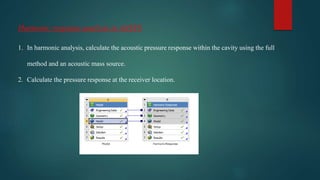Sound inside a rigid walled cavity
- 1. SOUND INSIDE A RIGID-WALLED CAVITY ANSYS WORKBENCH 15.0 sanjeet kumar singh
- 2. Learning outcomes 1. Calculate the undamped natural frequencies of a rigid walled cavity using ANSYS. 2. Use the FLUID 130 Fluid element in ANYS to model rigid wall cavity. 3. Sound pressure level at a receiver inside a rigid-wall rectangular cavity due to an acoustic volume velocity source, using the modal summation method. 4. Mode shape of a rigid-wall rectangular cavity 5. Conduct a harmonic response analysis in ANSYS
- 3. Rigid-walled rectangular cavity with an acoustic volume velocity source and receiver to measure the resulting sound pressure y x z Sound Source Receiver
- 4. Parameters of a Rigid-walled Cavity Description Parameter Value (m) Cavity: Length X Length Y Length Z Lx Ly Lz 0.5 m 0.3 m 1.1 m Acoustic Source: Location X Location Y Location Z Xs Ys Zs 0.15 m 0.12 m 0.0 m Acoustic Receiver Location X Location Y Location Z Xb Yb Zb 0.3 m 0.105 m 0.715 m Fluid : Speed of sound Density Number of modes C0 ρ0 Na 343 m/s 1.21 kg/m3 500 no units
- 7. The mess in finite element model will create nodes at the location of the source and receiver, and use hard key point points in the mess, which will create a key-point at a desired location and can not be changed. However, mapped meshing is not supported when hard key-points are used, so it is not possible to create a regular mesh with brick elements.
- 8. Undamped natural frequencies of a rigid walled cavity using ANSYS 40 natural frequencies of the cavity The 18th mode will be (1,1,2) mode. ANSYS does not have an in-built mechanism for determining the modal indices of acoustic(or structure) responses and therefore these have to be determined by viewing the response of the system and the user has to recognize the mode shape and appropriate model index
- 9. Harmonic response analysis in ANSYS 1. In harmonic analysis, calculate the acoustic pressure response within the cavity using the full method and an acoustic mass source. 2. Calculate the pressure response at the receiver location.
- 10. Under the harmonic response (B5) branch, click on the analysis setting branch. Change all the setting according to show in the figure. Solution intervals 500, which will give a frequency spacing of 1 Hz. Save MAPDL db to yes as the database is needed for post-processing of the acoustic results.
- 11. Define two named selection objects that correspond to the nodes where the acoustic source and microphone are located as listed in table in slide no 4. The worksheet (Model (A4,B4)-insert-Named selection-row scoping method-worksheet) use to select a node by initially selecting a group of nodes and then filtering the set. After the filtering operation, one node remaining in the selection set.
- 12. The name selection have been defined for the nodes for the acoustic source and microphone, the acoustic source is defined and acoustic pressure can be calculated at the microphone.
- 13. Sound pressure level at Receiver (microphone )














